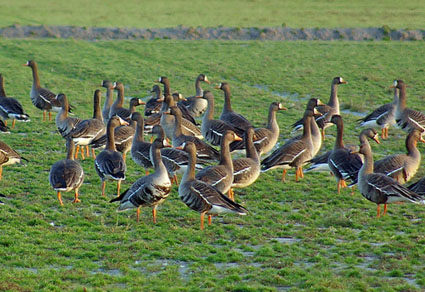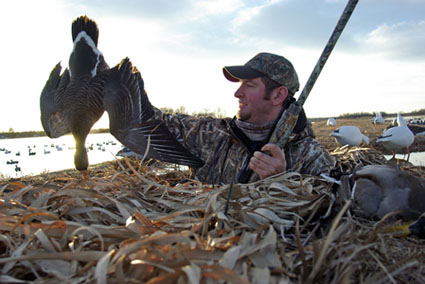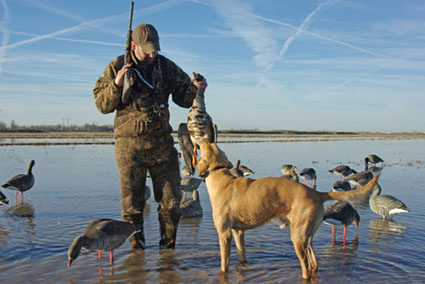 Flocks of white-fronted geese are becoming increasingly common throughout much of the birds’ range. |
According to the U.S. Fish and Wildlife Service, in 2009, 643,900 goose hunters harvested 3,327,000 geese in the U.S. Canada geese were killed in the greatest numbers, with 2.7 million harvested, follow distantly by snow geese at 341,540 and white-fronted geese at 205,243.
Despite the fact that white-fronts aren’t killed as often as their Canada and snow goose kin, many U.S. waterfowlers are discovering there is great challenge and exhilaration to be found when hunting white-fronted geese specifically.
Description And Range
A common nickname for white-fronts is “specklebelly,” a reference to the broken black barring on the breast of mature birds. The name “white-front” notes the white patch or “front” edging the bill of adult birds. These are medium-sized geese, most weighing 4 to 6 pounds. They are agile on the wing. While Canada geese glide to a landing like huge bombers, white-fronts side-slip out of the sky in a near vertical descent. Their voice is distinctive: high-pitched and melodious, like laughter.
Major waves of white-fronts wing into the South in October and November from breeding grounds in arctic Canada and Alaska. Small flocks sometimes are seen in Oklahoma, Mississippi, Alabama and Atlantic coastal states, but the largest wintering flocks are in natural wetlands and agricultural lands of Louisiana, southeast Texas and southeast Arkansas. There also is a Pacific population of white-fronts that winters in the Central Valley of California.
As geese go, white-fronts are wary birds — difficult to approach and intolerant of human intrusions. They seem wilder than other geese and thus are among the most highly prized members of their clan.
Hunting Specks
Hunting geese of any sort is a lot of trouble. And because they are less common and more wary than Canadas or snows, white-fronts present a special challenge. If you hunt them right, with a large spread of decoys set out before first light in an area you’ve scouted, a specklebelly hunt represents a considerable investment of time.
 Specklebellies are considered special prizes because of their wary nature and delectable table qualities. |
Begin preparing well before the season. Secure permission to hunt on farms you believe geese will use during the coming winter. Many farmers lease their fields for hunting or hunt the land themselves. But geese sometimes damage crops, and landowners often allow respectable sportsmen to goose hunt if plans are made before the season.
Obtain permission to hunt several fields if possible. There’s no way to know where geese will be day to day. Fortunately, specklebellies are fairly predictable, wintering in the same general areas year after year. A flock in a particular area last winter will usually be in the same vicinity this year and next year, too, if habitat conditions remain unchanged.
Study goose movement patterns throughout the season, identifying feeding, loafing and roosting sites, and flyways between each. When specklebellies start feeding in an area, they generally continue coming back until the food supply is exhausted. If you had no luck hunting them on one area, you might have opportunities when they move to a new feeding site. If they fly over your hunting sites when traveling between roosting and feeding areas, you might be able to lure them in with decoys and calling.
Realistic specklebelly decoys available from several manufacturers can be used alone in your decoy spread. But because white-fronts often flock with snow geese, many hunters use the same inexpensive decoys often used for snow geese, such as white trash bags filled with rice straw or white rags staked down with pegs. Spreads of 500 or more aren’t unusual, with a lesser number of wind socks, silhouettes, shells and full-bodied specklebelly decoys. White-fronts tend to gather in small groups at the edge of snow goose flocks, so decoys resembling white-fronts should be positioned to imitate that behavior.
Arrive at your hunting area before daylight, and hunt with several partners to hasten decoy placement. Space decoys about five to 10 feet apart to lend the appearance of a relaxed feeding flock and provide space between decoys for an approaching flock to land.
 A successful white-fronted goose hunt requires a lot of preseason planning and preparation. |
Some hunters dig knee-deep pits in the field, big enough to put their feet in while sitting comfortably on the ground. Dirt is piled on the downwind side (the side from which geese will approach), and when geese drop into the spread, hunters lean forward, using the dirt for concealment.
When properly camouflaged, you can lay in the decoys without being detected. In snow-goose decoy spreads, hunters often wear white smocks, coveralls or old sheets and become, in effect, part of the decoy spread. Hunters should be positioned to shoot toward the downwind side of the decoys, the direction from which geese generally come.
Calling And Eating
Specklebellies have a different call than Canadas or snows. It helps to obtain and study an audio or videotape that teaches proper sounds.
One call to use is the two-note yodel, made by saying “wa-wa, wa-wa...” into the call. Both high-pitched and low-pitched yodels are used as a hail call to draw distant birds’ attention. When a flock gets close, switch to the feeding call, which is made by grunting “kuluck” into the tube. Continue calling until you shoot.
Specklebellies are delicious. The meat is considered by many to be superior in taste to Canadas or snow geese. Pluck and draw the birds and roast in the oven 18 to 20 minutes per pound at 325 degrees.
Season dates and bag limits are set in late summer within frameworks established by the U.S. Fish and Wildlife Service. Contact your state wildlife agency to obtain a copy of the current migratory birds hunting regulations guide listing white-fronted goose hunting season dates and restrictions.
Note: Keith Sutton is the author of numerous books on hunting, fishing and the outdoors. Autographed copies are available through his website, www.catfishsutton.com.






